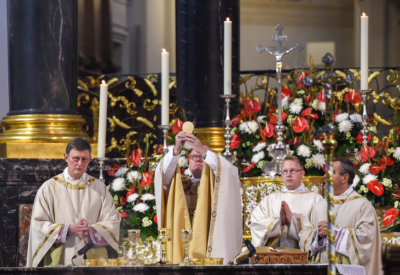 In our previous article we talked about the Real Presence of Jesus in the Eucharist as the true and ancient teaching of the Church. What was affirmed at the Council of Trent, was just that – an affirmation of what was held from the beginning of the Church. The teaching and belief of the Real Presence has been consistent, but language has not as we talked about in our previous post that centered on the difficulties of using the word “real” in modern conversation and catechesis. The previous post left you with some homework:
In our previous article we talked about the Real Presence of Jesus in the Eucharist as the true and ancient teaching of the Church. What was affirmed at the Council of Trent, was just that – an affirmation of what was held from the beginning of the Church. The teaching and belief of the Real Presence has been consistent, but language has not as we talked about in our previous post that centered on the difficulties of using the word “real” in modern conversation and catechesis. The previous post left you with some homework:
“Is the Real Presence in the Eucharist “real” or only “spiritual”? Next week we will continue this train of thought, but here is some homework for you. Is love real? Is your love for you spouse, your kids, your parents, your grandparents, your significant other – is it real. How do you differentiate it from “spiritual”? Can you measure it consistently and repeatedly? Is it more than feelings, hormones, biological imperative, or other “real” explanations? Is love real? …see you next week.”
There is a scene in the movie “Contact” (1997) in which the pure scientist played by Jodie Foster is talking with the spiritual advisor to the first contact project, played by Matthew McConaughey. His experience of God is dismissed by Foster as “you needed to see God.” In other words, a psychological fill-in-the-need. McConaughey asks Foster if she loved her father (a huge influence in her life, but now deceased). She answers that yes she did very much so. McConaughey simply asks her to prove it – a roundabout way of asking her if love was real or just another “fill-in-the-need.”
Ask someone in love, if love is real, the answer is an emphatic, joyful “Yes” even though it cannot be consistently and repeatedly measured or categorized. It is so real that one searches for it, finds the other and changes their life, and would die for the one loved. That’s about as real as it gets. True, some will dismiss it as hormonal, cultural patterning, biological imperative of our genes, or some such other thing, but I leave you to decide.
OK, so love is real. Is love spiritual? Apart from rehearsing all the linguistic, cultural and religious difficulties of the word “spiritual,” I would simply say that in the Christian tradition, we all hold that God is Love – pretty solidly in the spiritual camp. Ok, is love symbolic?
First, let’s ask, what is a sign? A sign is an object used to represent or communicate meaning. And to be effective, it has to have universal acceptance. If you are driving along the roadways and come to an intersection with an octagonal, red sign – even without the writing – it is universally accepted that it has one and only one meaning: stop. There are lots of signs related to driving but also in other aspects of life: a rotating red, white, and blue pole: barber shop. There are lots of examples. The point is that a “sign” only has one meaning. A symbol is more complex.
A symbol can have many meanings. Consider the Cross. Is it a symbol of Roman Empire control and authority? Yes. Is it a symbol of Christianity pointing to Salvation? Yes. That’s the way symbols work.
So, back to the Eucharist. Is it real? Yes (see the previous post). Is it a sign? Yes. Is it a symbol? Yes. Is it just a symbol and nothing more? No. But it does operate as a symbol in that it points to something beyond itself, but it is a unique symbol in that it also points to itself as a reality: Jesus truly present, body and soul, humanity and divinity. How can it be both? It occupies that same place as love: real, spiritual, sign, symbol. Should we be surprised to “locate” it there? Not really, afterall, God is love.
The Eucharist, truly the Body and Blood of Christ, are not symbols only. As St. John Damascene wrote: “The bread and wine are not a foreshadowing of the body and blood of Christ—By no means!—but the actual deified body of the Lord, because the Lord Himself said: ‘This is my body’; not ‘a foreshadowing of my body’ but ‘my body,’ and not ‘a foreshadowing of my blood’ but ‘my blood'” ( The Orthodox Faith, IV [PG 94, 1148-49]). At the same time, however, in the setting of the Last Supper, the shared meal is highly symbolic – pointing back into the Old Testament and the promises made while pointing forward to the heavenly banquet table, while at the same time pointing to Christ.
If asked if the Eucharist is just a symbol, the fuller answer is “Yes, but so much more… let me tell you…”